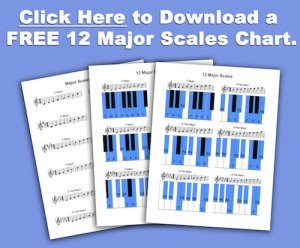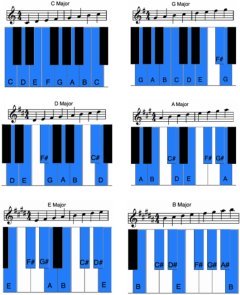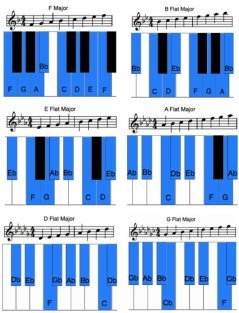Each of the 12 Major Scales correspond with one of the twelve notes on the piano keyboard. Each note on the piano has a major scale that starts and ends on the note the scale derives from.
In other words, if you pick any note on the piano, there will be a scale that goes along with that note.
Each scale has a key signature which tells the musician how many sharps or flats are in the key.
In this lesson I’m going to show you a simple trick that you can use to find any of the major scales.
12 Major Scales Charts
To make things super easy for you, I have included a Free chart that includes all the major scales in an easy to read format.
You can download a copy of the 12 major scales written on sheet music exactly like the image below.
I have also included a helpful chart with piano notes for each of the scales. You can print and download these for future reference.

Major Scales Chart

Major Scales Key Chart – Sharps

Major Scales Key Chart – Flats

About The Major Scale
Each major has a unique set of notes. Even though these notes are different, each scale sounds almost identical. Only people with a very trained ear can tell the difference between one key or another just by listening.
The reason for this is beacuse the distance between each note stays the same. This is known as an interval.
If you listen to the audio below you can hear what the C Major Scale sounds like.
C Major Scale
This next clip is the D Major Scale.
Listen to this scale closely. Can hear how it sounds almost identical to the C Major Scale? The C Major Scale and D Major Scale have the same intervals making them sound similar.
This is why you can play a song in any key. Since the intervals are the same, you can play a song in any key and it will sound exactly the same just a little higher or lower in pitch.
D Major Scale
Because the intervals are the same, a musician can play a song in any of the 12 keys.
So…. if you learn every key, you can then learn to play any song in any of the twelve keys.
Even though the intervals for the 12 major scales are the same, the notes in each scale are different. Take a look at the example:
C Major Scale: C-D-E-F-G-A-B-C
D Major Scale: D-E-F#-G-A-B-C#-D
Each major scale has the same intervals, but the notes in each scale are different as shown above.
Whole Steps and Half Steps
To make a major scale you must understand the difference between a whole step and a half step. All major scales are built from a pattern of whole steps and half steps.
A half step is the smallest distance in music. Moving from one note to the note directly next to it is an example of a half step.
Moving from C to a Db is a half step.
A whole step is a combination of two half steps. Taking two half steps and combining them together creates a whole step.
Two half steps make a whole step.
Moving from C to D is a whole step.
Moving from C to Db is one half step, then moving from Db to D is the second half step. This movement is known as a whole step.
If you need more help with half steps and whole steps, click the links above for a more detailed explanation.
Let’s Make A Major Scale!
To make one of the 12 major scales you have to use a certain combination of whole steps and half steps. Once you learn this pattern you will be able to apply it to any major scale.
Once you decide which scale it is you want to play, find the note which the scale is named after. For example, the C Major Scale would start on a C note.
This starting note is called the Root. This will be the foundation in which the major scale is built.
Each of the 12 Major Scales are made up of seven different notes. It starts on a root, and ends on a root. The scale itself only has seven notes, but often times an additional root is added to the top of the scale giving is eight notes.
There are only seven unique notes in the 12 major scales.
To build a major scale you have to follow a pattern of half steps and whole steps. To build this scale you must follow the pattern below:
Major Scale Pattern
Whole Step, Whole Step, Half Step, Whole Step, Whole Step, Whole Step, Half Step
If you follow this pattern you can make any major scale you want. Pick any note on the keyboard and follow the pattern above.
If you paid close attention you would have noticed that there are more than 12 major scales in the chart above. There are actually 15 major scales.
How can there 15 major scales if there are only 12 keys on the piano?
That’s because there are what’s known as enharmonic scales. This means that some of these scales repeat themselves but will be called another scale.
But that’s going to be in another lesson. You can find more about enharmonic equivalents here.
The 12 Major Scales are crucial to learning the piano. Once you learn all the scales, you will be able to play songs in any key. You will also be able to transpose or change the key of a song to whatever key works best for the situation you are in.

Go From 12 Major Scales Back to Piano Theory
Back to Home Page

